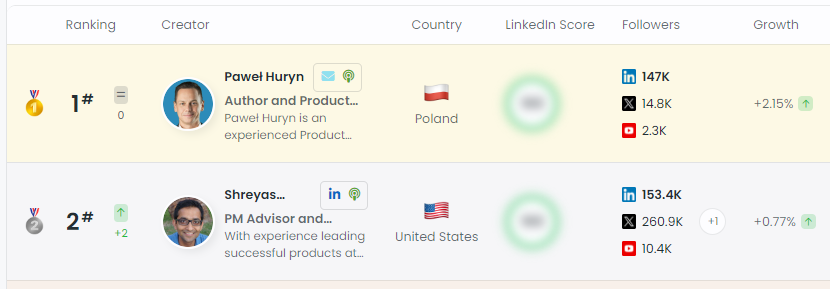The Secrets of Copywriting: Proven Ways to Transform Your Writing as a PM
Effective communication is the #1 skill for PM. But many struggle with writing. Their messages are ignored and fail to drive the expected action.
Hey, Paweł here. Welcome to the premium edition of The Product Compass 🔐
Every Saturday, I share actionable tips to boost your PM career.
If you are not a premium subscriber, here’s what you might have missed:
The Secrets of Copywriting: Proven Ways to Transform Your Writing as a PM
According to the survey performed by
effective communication is the #1 skill for PM.I've noticed that many PMs struggle with writing. Their messages are ignored and fail to drive the expected action.
Luckily, it’s a skill you can learn easily.
Before we go further, why would you listen to my advice?
In the last 12 months:
I went from 45K to 147,001 LinkedIn followers.
My content was displayed 45,176,869 times with 330,147 engagements (comments, likes, shares).
I’m currently the #1 Product Management LinkedIn creator, according to Favikon (based exclusively on data: growth, impressions, engagements):

While not everyone wants to create social media content, the same principles can be applied to communication with customers, colleagues, and stakeholders in various formats like Slack, emails, and landing pages.
In this issue, I present simple techniques you can apply to transform your writing as a PM:
🔒 How to start (the hook).
🔒 How to convey your core message.
🔒 How to drive action (CTA).
🔒 A copywriter’s checklist.
1. How to start (the hook)
The hook, the title, or the headline.
Regardless of the context, your first task is to get the attention, select the right audience, communicate the value, and draw the reader into your core message.
You only have 1-2 seconds to stop the scrolling. And the single most critical question you need to answer is “So what?”
Your reader wants to know:
Target: Is it relevant to me?
Unique, specific value: What unique, specific value does it offer? Does this person teach, inspire, understand, entertain, or make me think?
Immediate action: Is it urgent? Interesting? Why should I invest my time right now? Can I lose something by not taking action?
Common techniques
The common techniques:
Use numbers and surprising facts to draw attention.
Refer to the current events (New Year, something happening at Airbnb, etc.).
Present a contrarian view to spark discussion (use carefully).
Leverage the loss aversion bias.
Use powerful words like “steal,” “boost,” “secret,” “free,” “how to,” “easy,” “quick,” “unique,” “crush,” “ace,” “madness,” or “proven.” Here are 352 words you can use.
Practical examples
Keep reading with a 7-day free trial
Subscribe to The Product Compass to keep reading this post and get 7 days of free access to the full post archives.




